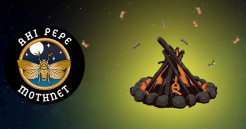1: Ahi Pepe MothNet
I hikaina te ahi tītī, engari i Whakapoapoa kē i te pepe
The fire was lit to attract the muttonbirds and the moths flew into it
The name Ahi Pepe is based on this whakataukī by Te Whiti o Rongomai.
Like moths, tītī are attracted to light so a setting a fire on a headland was common hunting practice.
Lighting fires was a common hunting practice. Adult tītī returning from a day’s feeding were, like moths, attracted to the light. ‘Many of the places where the home-seeking old birds were taken were known as ahi-tītī (tītī fire) simply because at such places a fire was always kindled by fowlers to attract the birds as they winged their way inland in dusk or darkness.’
The whakataukī talks about setting a trap which then lures in something or someone else instead of the intended target. A modern context might be when someone organizes a fancy wedding feast but then uninvited wedding crashers eat all the food.
The analogy of moths being attracted to the flame represents moths being attracted to our lights, and people being encouraged to be interested in moths and their environment. 'Ahi' means fire and 'Pepe' means moth, which literally translated means the 'moth fire' - so Ahi Pepe.
This unit introduces Ahi Pepe MothNet and a few of the over 2000 moth species found in Aotearoa. Most (over 90%) of these moths are endemic to New Zealand (found only in New Zealand). This means that they are extra special and we need to really make an effort to care for them. People tend to care more about people, places, and things that we know well or feel an affinity with. We are more likely to protect places if they are special to us, for example if we have happy memories of a childhood swimming hole. Species are the same. If we don’t even know that a moth exists we are unlikely to worry about protecting its home.
The Ahi Pepe Light activities are designed to work alongside the Puka Whakamārama o te Pepe Nui – Beginners’ Guide to the Macro moths either with the Ahi Pepe MothNet experiment or alone.
Living things; Biology; Culture; Language; Art
